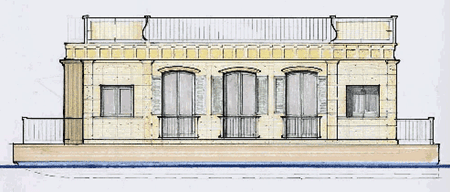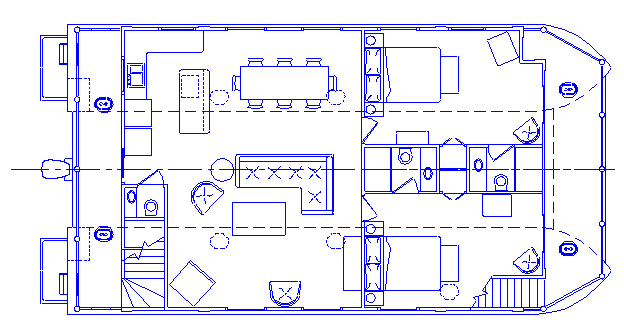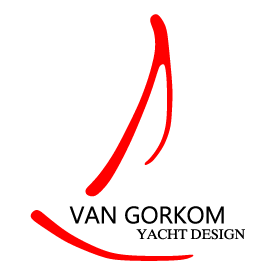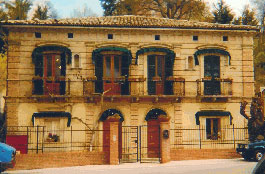And Now for Something Completely Different….Water Mansions
Back in the late summer of 2004 I was contracted by a client who wanted me to design and engineer a luxury houseboat. That in itself isn’t so unusual, except for the fact that it had to resemble an Italian villa. I have to admit I was a little skeptical. But my mind soon changed after consulting with the client, whose prior experience with houseboats and appreciation for classic architecture convinced me that this could be a unique opportunity to do something very special.
“Form versus function” is always a balancing act, and no where is that more applicable than in the design of boats. So besides the desired aesthetics qualities the client wanted, this houseboat was to be 50 feet or under, a single story structure, have a spacious roof deck, and have open interior living spaces in keeping with the mansion style of high ceilings. There had to be two bedrooms, each with their own bathrooms, a living/dining area for entertaining, and a large gourmet kitchen. In addition, the houseboat had to be motorized (not just a floating house) and fully self-sufficient. It also had to have a robust structure.
The first job was to draw up a general arrangement and fit an interior that would meet the client’s needs. This pretty much dictated the beam of the vessel (26’8”) and, in part, the type of hull form we would use to support the house. From a weight, beam and hydrodynamic point of view, a simple catamaran hull was the only real choice. It also made for an extremely stable platform on which to build the house.

In parallel with the general arrangement study, we were also working on the exterior look of the house, which was critical to the success of the project. With classical architecture not really being my forte, I brought in a well respected New England architect (and college buddy) Chris Hoell to design the façade. Chris took the photo that had been supplied by the client of an actual Italian villa, and produced exactly the desired look and feel we were after.
With the conceptual phase of the project in hand, we set about engineering the hulls, cross-beam structure, and house. The geometries of the hulls are simple developable surfaces, each eight feet in beam. Steel was the material of choice for the hulls and cross-beam, given its strength, durability, and relatively low construction costs. These structures were engineered to the American Bureau of Shipping’s scantlings rule for displacement-type power vessels. A check of the cross-beam structure was made using the Dinsenbacher criteria for estimating loads on catamaran cross-structures.
The decision was made to build the house as a wood-framed structure using marine grade materials. However, due to the unique styling of the house, it was necessary to find a durable, whether proof, light-weight material that could be used to simulate old-style masonry work. It just so happens that there is a company in Rhode Island that makes exactly the perfect product for this application. Dryvit is a commercial exterior wall and insulation system that can be textured and colored to just about any finish you could want. It has a proven record in adverse environments and it’s relatively easy to work with. Residential building codes, along with ABYC standards, were used as the basis to design the house structures.
As mentioned in the client’s criteria, the houseboat needed to be a self-propelled, self-contained vessel capable of operating in protected waters (harbors, rivers, inland water-ways, etc.). One of the reasons we proposed a catamaran was for its easily driven, low drag, hull form. In gauging the power requirements, we conducted a power analysis and determined that a single 250 hp engine would push the houseboat along at a cruising speed of 8 knots. The engine will be on a hydraulic retractable mount. To aid in the maneuverability of the vessel, there will be a bow thruster in the port hull. In addition, there will be an onboard generator, inverters and batteries providing more than enough power for all domestic needs. The houseboat will carry adequate fuel and water stored in the tanks located in each of the hulls.
Interior Description
The arrangement of the interior was not only meant to compliment the grand style of the house, it was also meant to be quite functional. The main boarding area is from the after lower deck, where there are also port and starboard swim platform/dingy landings. The primary entrance into the house is through the galley with a half bathroom on the starboard side. The gourmet kitchen is well equipped with a full-sized refrigerator, an electric countertop stove and oven, a trash compactor, a stacked washer and dryer unit, and a dumb waiter that serves the upper deck.
The galley opens up into a large central entertaining area complete with a formal dining space and a generous floor plan for a comfortable lounge suite. Three-quarter height windows bath this space in natural light. In the forward end of the houseboat there are two luxurious staterooms, each with their own full bathroom. Besides direct access into the main living area, each of these cabins also has French doors opening up onto the forward lower deck.
The upper deck will be the place to be during the summer months. There will be room for a Jacuzzi, a bar, a dining area, and a barbeque. The helm stations (port and starboard), will also be located on the upper deck so that the operator of the houseboat will have a clear field of vision when driving the vessel or approaching a dock. There are two stairways up to this deck, one forward and one aft.
Unfortunately, the Villa Houseboat has yet to be built, but Van Gorkom Yacht Design definitely realizes the potential for this type of houseboat in any architectural style, from classic to contemporary. We like to call them “Water Mansions”. We feel that the overall elegance and style of the houseboat does not have to be compromised by the practical aspects of having a motorized vessel.


